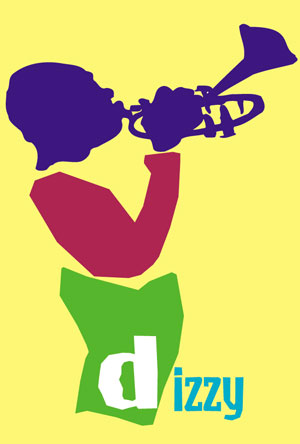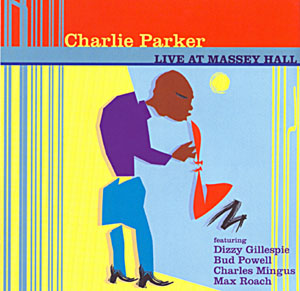When Was Dizzy Gillespie Awarded the National Medal of Arts
Dizzy Gillespie Biography

The father of BEBOP and the Airheaded Gillespie Biography introduces y'all to the "Daddy"!
What do yous call a dude who innovates jazz and keeps a cool look at the aforementioned time? A existent 'JAZZ-True cat" thats what! 50 years after helping establish a new way of revolutionary jazz that came to be known as bebop, Dizzy Gillespie'due south music is nonetheless a major contributing factor in the evolution of modern jazz.
Dizzy Gillespie Biography: John Birks Gillespie was born October 21, 1917, in Cheraw, South Carolina, to John and Lottie Gillespie. The final of nine children, Gillespie'due south begetter was abusive and unusually strict and the youngest Gillespie grew up difficult and strong. It helped him to be a tough kind of dude in that sometime segragated United states of america.
When Gillespie was ten, his male parent died and left the family in terrible fiscal trouble. Around this fourth dimension Gillespie's English teacher introduced him to music, and he presently joined the school band. At first he played the trombone, but switched to the trumpet after borrowing a neighbour's and immediately falling in dear with the instrument.
Over the next several years Gillespie played with local bands—to both blackness and white audiences—until his family moved to Philadelphia, Pennsylvania. The kid was always smile ands had a cool strut from the go become!
In Philly and New York Gillespie played with bands in Philadelphia from 1935 to 1937 before moving to New York City. In Philadelphia Gillespie earned his nickname for his unpredictable and funny behavior.
When Gillespie was in the Frankie Fairfax band in Philadelphia he carried his new trumpet in a paper pocketbook, an act that inspired swain musicians like Bill Doggett to call him "Dizzy." The dude had a manner of lightening upwards a situation that could seem tense and that is a skill in itself...
In New York City the Teddy Hill Orchestra hired Gillespie for a European tour. By 1937—when he was just 19—Gillespie had already made a name for himself among New York musicians, who could non aid but notice his radically fresh accept on solo (single) trumpet playing. The cat could play and his sound was off the claw!
Gillespie made his first recordings with the Teddy Loma Orchestra simply prior to leaving for Europe with "The Cotton Order Show."
Gillespie joined the Cab Calloway (1907–1994) Orchestra in 1939 and stayed until 1941. Calloway played the Cotton fiber Club and toured extensively. During this period Gillespie continued to play all-nighttime jam sessions at Minton's and Monroe's Uptown Business firm to develop his musical knowledge and mode.
Having a foundation in Cab Calloway's band gave Lightheaded the confidence to tretch out a bit and become hip with the jive of jazz!
Gillespie joined the Earl "Fatha" Hines band in 1942, about the aforementioned time Charlie Parker (1920–1955) did. Although Parker became famous as an alto saxophonist, he was playing tenor sax at that time. Gillespie first met Parker in Kansas Metropolis, Missouri, in 1940 when he was on tour with Cab Calloway.
The ii of them jammed together at the Booker T. Washington Hotel for several hours.
Bebop born on 52nd Street
A large function of the Earl Hines band departed in 1943 to form a new group headed by Billy Eckstine. Former Hines members who joined Eckstine included Sarah Vaughan (1924–1990), Gillespie, Parker, and others. Gillespie became musical director for Eckstine, whose backers got him a chore on 52nd Street.
After leaving Eckstine, Gillespie substituted in the Duke Ellington (1899–1974) Orchestra for about four weeks, and so formed his own grouping to play at the newly opened Onyx Social club on 52nd Street. Gillespie had been playing bebop (a new, radically unlike form of jazz) whenever he could since 1940, the year he married Lorraine Willis.
Now he was able to play it full fourth dimension. 52nd Street became the proving ground for a new jazz style that had previously been played primarily at late nighttime jam sessions. "The opening of the Onyx Club represented the birth of the bebop era," Gillespie recalled in his book, To Be or Not to Bop.
Dizz and Bird created Be Bop and they made the world mind to this outrageous music that challenged the listener to... Heed WITH You lot MIND AND EARS!
As well in 1944 Gillespie received the New Star Award from Esquire mag, the kickoff of many awards he would receive in his career. Describing the new fashion his quintet played, Gillespie wrote, "We'd take the chord structures of various standard and popular tunes and create new chords, melodies, and songs from them."
Gillespie's quintet and the presentation of mod jazz reached its height in 1953—with a concert at Massey Hall in Toronto that featured Gillespie, Parker, Bud Powell (1924–1966), Max Roach (1924–), and legendary jazz bassist Charles Mingus (1922–1979).
Billed by jazz critics as "the greatest jazz concert ever," it was recorded by Mingus and later released on Debut Records.Gillespie's legacy
In 1989, the year he turned lxx-ii, Dizzy Gillespie received a Lifetime Accomplishment Accolade at the National Association of Recording Arts and Sciences' Grammy Laurels ceremonies. The laurels—i of many awarded to the trumpet virtuoso—recognized nearly fifty years of pioneering jazz performances. That same year he received the National Medal of Arts from President George Bush (1924–).
Simply the dude never slowed down fifty-fifty in his old age Dizzy was still setting out and wowing audiences all over the globe! And he kept that wonderfulssmile on his face as wel...
Not letting age slow him down, in 1989 Gillespie gave three hundred performances in twenty-vii countries, appeared in one hundred U.Due south. cities in thirty-one states and the District of Columbia, headlined 3 boob tube specials, performed with two symphonies, and recorded 4 albums.
The adjacent year, at the Kennedy Center for the Performing Arts ceremonies celebrating the centennial of American jazz, Gillespie received the American Society of Composers, Authors, and Publishers' Knuckles Award for fifty years of achievement.
Although Gillespie's declining wellness was due to pancreatic (having to practice with the organ that helps digestion) cancer, Gillespie continued to play the music that he loved late into his life. His terminal public appearance was in Seattle in February of 1992. Gillespie passed abroad quietly in his sleep on October 6, 1993, at the age of seventy-five.
Back to Dizzy Gillespie Biography and other Jazz Cats!

Source: https://www.the-jazz-cat.com/dizzy-gillespie-biography.html
0 Response to "When Was Dizzy Gillespie Awarded the National Medal of Arts"
Post a Comment